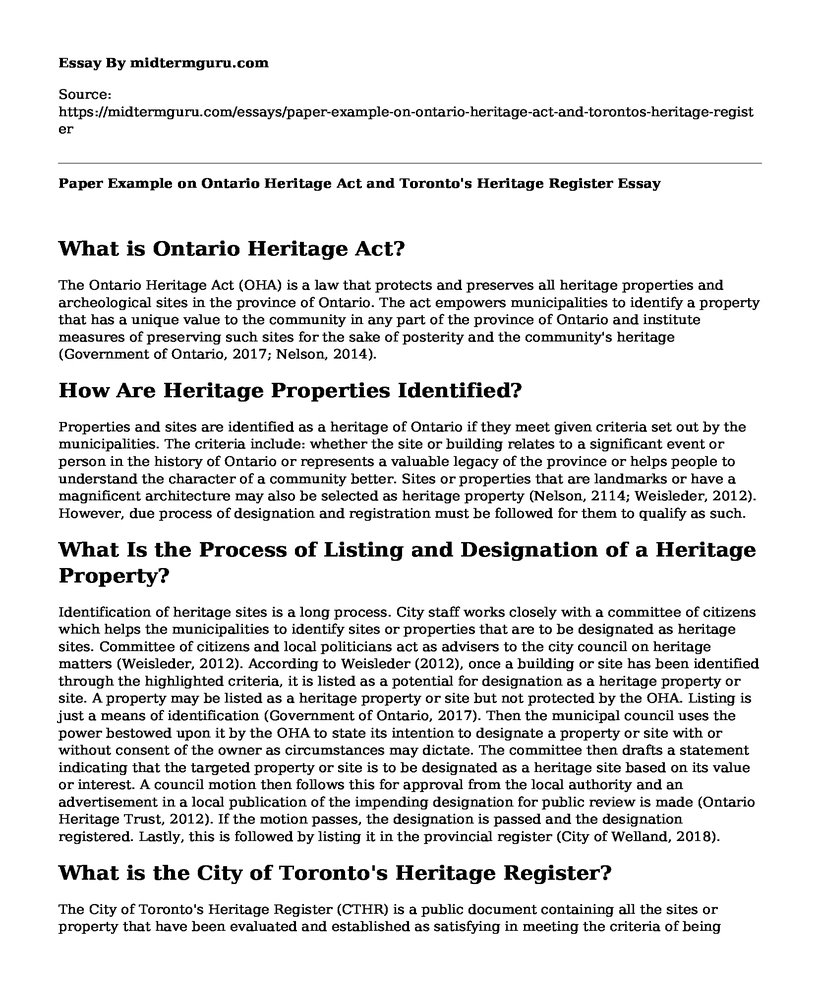What is Ontario Heritage Act?
The Ontario Heritage Act (OHA) is a law that protects and preserves all heritage properties and archeological sites in the province of Ontario. The act empowers municipalities to identify a property that has a unique value to the community in any part of the province of Ontario and institute measures of preserving such sites for the sake of posterity and the community's heritage (Government of Ontario, 2017; Nelson, 2014).
How Are Heritage Properties Identified?
Properties and sites are identified as a heritage of Ontario if they meet given criteria set out by the municipalities. The criteria include: whether the site or building relates to a significant event or person in the history of Ontario or represents a valuable legacy of the province or helps people to understand the character of a community better. Sites or properties that are landmarks or have a magnificent architecture may also be selected as heritage property (Nelson, 2114; Weisleder, 2012). However, due process of designation and registration must be followed for them to qualify as such.
What Is the Process of Listing and Designation of a Heritage Property?
Identification of heritage sites is a long process. City staff works closely with a committee of citizens which helps the municipalities to identify sites or properties that are to be designated as heritage sites. Committee of citizens and local politicians act as advisers to the city council on heritage matters (Weisleder, 2012). According to Weisleder (2012), once a building or site has been identified through the highlighted criteria, it is listed as a potential for designation as a heritage property or site. A property may be listed as a heritage property or site but not protected by the OHA. Listing is just a means of identification (Government of Ontario, 2017). Then the municipal council uses the power bestowed upon it by the OHA to state its intention to designate a property or site with or without consent of the owner as circumstances may dictate. The committee then drafts a statement indicating that the targeted property or site is to be designated as a heritage site based on its value or interest. A council motion then follows this for approval from the local authority and an advertisement in a local publication of the impending designation for public review is made (Ontario Heritage Trust, 2012). If the motion passes, the designation is passed and the designation registered. Lastly, this is followed by listing it in the provincial register (City of Welland, 2018).
What is the City of Toronto's Heritage Register?
The City of Toronto's Heritage Register (CTHR) is a public document containing all the sites or property that have been evaluated and established as satisfying in meeting the criteria of being classified as a national heritage. The register may include both listed and designated properties. It usually captures the legal description of the site or property, name plus the address of the owner, and also a statement that explains the cultural heritage value such property confers to the community (City of Toronto, 2017).
Importance of Heritage Designation
From a well-considered perspective, the designation is a fundamental practice to the history of the nation. The significance of preserving cultural heritage sites and properties is that they play a critical role in revealing the story of Canada. Archeological sites and cultural heritage property offer information on how the political, social and economic configurations of the country have changed over centuries besides acting as tourist attracts for both domestic and international tourists. As such, it helps to inform current generations of the negative or positive happenings of the past thereby helping them understand the mistakes and success of those who lived before them. This information is essential in shaping a better future for the country.
References
City of Toronto. (2017, November 24). Heritage register. Retrieved from https://www.toronto.ca/city-government/planning-development/heritage-preservation/heritage-register/
City of Welland. (2018). Heritage - Designating a property. Retrieved from https://www.welland.ca/Heritage/designatinginfo.asp
Government of Ontario. (2017). Ontario Heritage Act. Retrieved from http://www.mtc.gov.on.ca/en/heritage/heritage_act.shtml
Nelson, G. (2014). Beyond the Global City: Understanding and Planning for the Diversity of Ontario. Montreal: McGill-Queen's University Press.
Ontario Heritage Trust. (2012). Benefits of heritage designation under the Ontario Heritage Act. Retrieved from https://www.heritagetrust.on.ca/user_assets/documents/HIS-014-Benefits-of-heritage-designation-under-the-Ontario-Heritage-Act-ENG.pdf
Weisleder, M. (2012, February 10). The hidden value in heritage properties. Retrieved from https://www.thestar.com/life/homes/2012/02/10/the_hidden_value_in_heritage_properties.html
Cite this page
Paper Example on Ontario Heritage Act and Toronto's Heritage Register. (2022, Oct 17). Retrieved from https://midtermguru.com/essays/paper-example-on-ontario-heritage-act-and-torontos-heritage-register
If you are the original author of this essay and no longer wish to have it published on the midtermguru.com website, please click below to request its removal:
- Essay Sample: Should US Prisoners Be Given Minimal or Extended Medical Care?
- Introduction of ASIC v Hellicar Caselaw - Paper Example
- Hillary Clinton's Women's Rights Are Human Rights: Speech Analysis
- How Sex Workers Human Rights Are Being Violated Around the World? - Paper Example
- Freedom of Speech: Right to Express Without Restriction - Research Paper
- Exploring the Role of the Canada Border Agency as a Police Agency - Presentation Example
- News Example: 2 Men Charged in Minneapolis Triple Slaying







